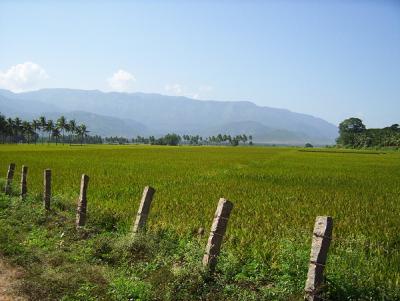Incentives needed to improve grain markets in India

This is a photo of a rice field in India. Credit: University of Illinois
Two University of Illinois economists analyzed infrastructure of interstate trade for food-grain crops in three Indian states and found that grain farmers are unable to cash in on India's market reforms and take advantage of a price difference between two or more markets.
“We wanted to see if there was more integration in the markets since the 2002 reforms,” said Kathy Baylis. “We were surprised at how little integration we saw. Apparently there are still a lot of regulations in place. A lot of the wholesale markets are not open other than right around harvest. There is a strong incentive to sell at harvest because if you don't you'd have to travel to Delhi or another major city. The ADM Institute for the Prevention of Postharvest Loss that provided the funding for this research is interested in storage, and what we found in India is that there was a huge disincentive to invest in on-farm storage because even if farmers could store their grain for six months or so, they wouldn't be able to sell it then.”
Baylis explained that, prior to the reforms of the early 2000s it was difficult in India to transport grain across state lines. The reforms made that easier and also expanded the number of people who could purchase and trade grain. Farmers used to have to go through a long, arduous process to become certified. The reforms eliminated some of those issues, but other problems still plague the system.
“Some people may think of this as only an engineering problem,” Baylis said, “where we just need to develop a really good place for them to store the grain. But if there isn't an incentive to store grain to sell later and get a better price, the extra storage won't help farm income.”
According to Baylis and her colleague Mindy Mallory, although India still needs some serious policy reform, small innovations could be facilitated to encourage more independent traders to get into the market.
“Anecdotally we heard that in places where there were more active traders, farmers were able to benefit from this market arbitrage potential,” Baylis said. “They weren't stuck looking at their own local market. If they worked with a trader, they could keep an eye on what's happening in the city and sell their grain two or three months after harvest.”
Baylis said that fruit and vegetable crops, which are highly perishable, tend to have less regulation than the grains and oilseeds.
Because they don't go through the government markets, traders are making investments to get the food from the farmer to the city.
“You have these parallel systems going on,” Baylis said. “One is regulated, very structured and not very efficient. One is unregulated and in some cases works well; in other cases, it is also a mess. For vegetable crops, if farmers don't have those linkages, they really can't sell perishable products. There's a massive lack of cold storage in India, for example.”
As an economist, Baylis said that she studies how policy can create headaches for farmers and on the consumer end of the supply chain.
“Global food security is often seen as a production issue, but often it's not just lack of water or access to the right seeds,” she said. “There has been evidence that major famines, weren't due to a lack of food production, they occurred because you had all of these other institutional crises or economic crises.
“Some people on the outside look at the postharvest loss in India and say we need to develop a better mouse trap – to develop better storage. Our point is that although that's a good thing, if you don't have the right policy and economic incentives, the best mouse trap still won't help.”
“Food Corporation of India and the Public Distribution System: Impacts on Market Integration in Wheat, Rice, and Pearl Millet,” co-authored by Mindy Mallory, was published in an issue of the Journal of Agribusiness.
Media Contact
More Information:
http://www.illinois.eduAll latest news from the category: Agricultural and Forestry Science
Newest articles

New model of neuronal circuit provides insight on eye movement
Working with week-old zebrafish larva, researchers at Weill Cornell Medicine and colleagues decoded how the connections formed by a network of neurons in the brainstem guide the fishes’ gaze. The…

Innovative protocol maps NMDA receptors in Alzheimer’s-Affected brains
Researchers from the Institute for Neurosciences (IN), a joint center of the Miguel Hernández University of Elche (UMH) and the Spanish National Research Council (CSIC), who are also part of…

New insights into sleep
…uncover key mechanisms related to cognitive function. Discovery suggests broad implications for giving brain a boost. While it’s well known that sleep enhances cognitive performance, the underlying neural mechanisms, particularly…



